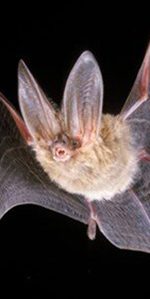| Northern Long-eared Myotis | ||
 |
Classification(s) : | Prey |
| Cat Name : | Bat | |
| Common Name : | Northern Long-eared Myotis | |
| Scientific Name : | Myotis septentrionalis | |
| Other Name(s) : | ||
| Physical Description : | The northern long-eared myotis has dark, leathery wings and a dark brown face, and is otherwise covered in golden brown fur. True to its name, it has long ears. |
|
| Physical Statistics : | Length: 3.2 – 3.8 Inches (80 – 96 Millimeters) |
|
| Behavior : | The northern long-eared myotis hibernates during winter and roosts under tree bark in the summer, spring, and fall. It mainly plucks insects from leaves, branches, and the ground, though occasionally it will take some from the air, and eats while hanging from a perch. |
|
| Social Organization : | Males and females roost separately, though females who are expecting or nursing young may form maternity colonies of fewer than 60 bats. |
|
| Approval Level : | None; The northern long-eared myotis is fairly common and its presence does not indicate a specific environmental situation. | |
| Kill Difficulty : | Low; The northern long-eared myotis is small and lacks any weaponry that would be harmful to cats. |
|
| Training Level : | Specialty - Bat; The northern long-eared myotis is nocturnal and spends lots of time in roosts or in the air, though due to its eating habits, it is perhaps slightly more accessible than other species of bat. |
|
| Hunting Tactic : | Bats | |
| Food Quality : | Low; The northern long-eared myotis is small and its poor taste and nutritional value make it hardly worth the effort one would put into hunting it. | |
